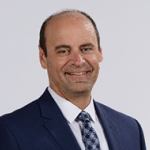When I arrived at Monsanto, the first thing I did was take a look at our IT strategy and how that mapped to our current infrastructure. To get an enterprise understanding, I also spent some time with our CFO and our Capital Review Board, talking to them about the state of our operations today.
It was pretty clear based on what I saw that the first thing we had to do was scale our base. We had invested pretty aggressively on "grow platforms," but we had built up a good amount of technical debt in the company as a result. We harvested efficiencies out of our infrastructure and did a good job at it, but we didn’t fully invest in the future.
To right our course, we initiated a program called Modernize, Secure, and Scale our Base. This initiative included improving our cyber security, modernizing our platform and assets, and promoting the migration of work packages to cloud.
We also looked at a network refresh. If you think about the data volume that a $15 billion company like Monsanto deals with, especially given our work in Internet of Things and collecting genomic data, it's in the petabyte range. It was pretty clear that our network was not built to handle that data volume. Video is a great surrogate to look at what you may need in a future network, because it’s dynamic, requires QOS, and has high bandwidth and burst. Looking at what your network might need to support a video-centric future will almost certainly give you a good picture of the environment you will need to drive that future.
In our case, we were able to say: "Yes, we need a refresh, and not just to get us to the next year or two. We need a refresh that’s dynamically driving where our data volumes are going to go." That future may lead us – or may lead you, depending on your industry – into software-defined networks. That should lead you to consider, what are the investments you need to start to make to establish that foundation and platform?
These kinds of discussion are very healthy because they give both IT and executive teams a much broader perspective on where you are and where you need to step-change your thinking to take you where you need to go.
The other factor to consider is what we call total cost to own. We’re not going to make an investment just to deliver a return on the investment in the asset. We have to think about sustainment of that asset as well. And based on this assessment we ask, “Do we need to do more? Are we in good shape? Are we being overly conservative or overly aggressive?”
Plugging in the executive team
Whatever you decide to do, the last point is always to execute on what you promise. To make that real, I provide an update every quarter to our executive team on the progress of our modernization and how we are scaling our base. That includes network refresh, continuity planning, globalization of support, measuring and monitoring, and hardening of security. All this gives our executives a pulse so they can ask, “How are we doing against those commitments?” It also allows them to have a dialogue with us around new concerns or something that has just emerged in the environment.
Reporting out in this way makes it more real for them. It’s not a back-office, behind-the-curtain discussion. It’s a front office, “Here’s what we’re doing” discussion, and because of the thought leadership they bring, we have a better IT strategy as a result of those dialogues.
That’s how we’re transforming our technology debt into assets. Bringing it all into the forefront is a great idea because it allows us to fund and drive our future company and base.



